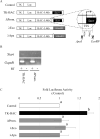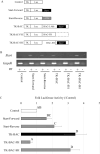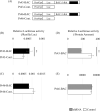Evidence for a functional role of Start, a long noncoding RNA, in mouse spermatocytes
- PMID: 36006924
- PMCID: PMC9409574
- DOI: 10.1371/journal.pone.0273279
Evidence for a functional role of Start, a long noncoding RNA, in mouse spermatocytes
Abstract
A mouse testis-specific long noncoding RNA (lncRNA), Start, is localized in the cytosol of Leydig cells and in the nucleus of pachytene spermatocytes. We previously showed that Start regulates steroidogenesis through controlling the expression of Star and Hsd3b1 genes in Leydig cells, but its function in germ cells was not known. Here we verified that a spermatocyte-specific protease gene, Prss43/Tessp-3, was downregulated in Start-knockout testes. To investigate the transcriptional regulatory activity of Start in spermatocytes, we first performed a series of reporter gene assays using a thymidine kinase promoter in spermatocyte-derived GC-2spd(ts) cells. A 5.4-kb genome sequence encompassing Start exhibited enhancer activity for this promoter, and the activity was decreased by knockdown of Start. Deletion of the Start promoter and replacement of the Start sequence abolished the enhancer activity and, consistently, the activity was detected in further experiments only when Start was actively transcribed. We then examined whether the Prss43/Tessp-3 gene could be a target of Start. A reporter gene assay demonstrated that the 5.4-kb sequence exhibited enhancer activity for a Prss43/Tessp-3 promoter in GC-2spd(ts) cells and that the activity was significantly decreased by knockdown of Start. These results suggest that Start functions in transcriptional activation of the Prss43/Tessp-3 gene in spermatocytes. Given that Start is presumed to regulate steroidogenic genes at the posttranscriptional level in Leydig cells, the function in spermatocytes is a novel role of Start. These findings provide an insight into multifunctionality of lncRNAs in the testis.
Conflict of interest statement
The authors have declared that no competing interests exist.
Figures





Similar articles
-
A genomic region transcribed into a long noncoding RNA interacts with the Prss42/Tessp-2 promoter in spermatocytes during mouse spermatogenesis, and its flanking sequences can function as enhancers.Mol Reprod Dev. 2016 Jun;83(6):541-57. doi: 10.1002/mrd.22650. Epub 2016 May 9. Mol Reprod Dev. 2016. PMID: 27111572
-
A conserved noncoding sequence can function as a spermatocyte-specific enhancer and a bidirectional promoter for a ubiquitously expressed gene and a testis-specific long noncoding RNA.J Mol Biol. 2014 Aug 26;426(17):3069-93. doi: 10.1016/j.jmb.2014.06.018. Epub 2014 Jul 11. J Mol Biol. 2014. PMID: 25020229
-
A Testis-Specific Long Noncoding RNA, Start, Is a Regulator of Steroidogenesis in Mouse Leydig Cells.Front Endocrinol (Lausanne). 2021 Apr 1;12:665874. doi: 10.3389/fendo.2021.665874. eCollection 2021. Front Endocrinol (Lausanne). 2021. PMID: 33897623 Free PMC article.
-
Pdha-2: a model for studying transcriptional regulation in early spermatocytes.Mol Reprod Dev. 1994 Oct;39(2):194-9. doi: 10.1002/mrd.1080390212. Mol Reprod Dev. 1994. PMID: 7826622 Review.
-
Regulation of aromatase gene expression in Leydig cells and germ cells.J Steroid Biochem Mol Biol. 2003 Sep;86(3-5):335-43. doi: 10.1016/s0960-0760(03)00343-1. J Steroid Biochem Mol Biol. 2003. PMID: 14623530 Review.
References
Publication types
MeSH terms
Substances
LinkOut - more resources
Full Text Sources
Molecular Biology Databases
Research Materials
Miscellaneous

